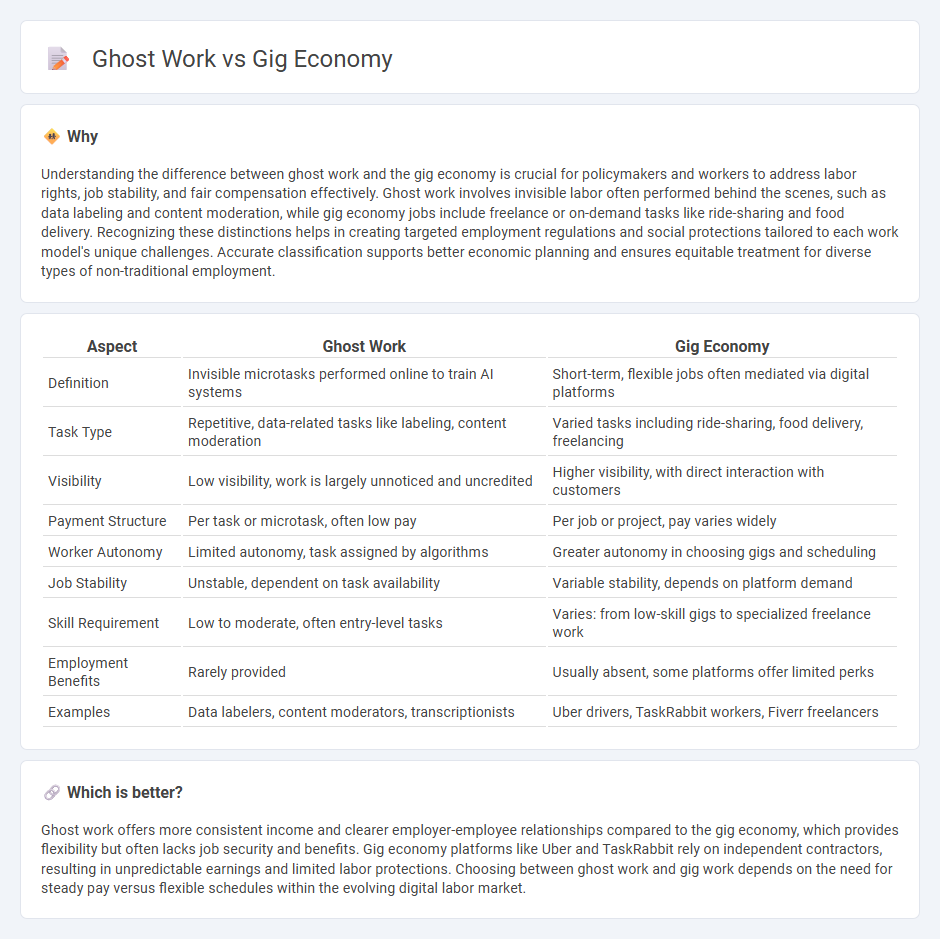
Ghost work refers to invisible labor performed remotely, often involving microtasks that power AI systems without public recognition. The gig economy encompasses flexible, short-term jobs facilitated by digital platforms, providing workers with autonomy but limited benefits. Explore further to understand how these evolving employment models impact the future of work.
Why it is important
Understanding the difference between ghost work and the gig economy is crucial for policymakers and workers to address labor rights, job stability, and fair compensation effectively. Ghost work involves invisible labor often performed behind the scenes, such as data labeling and content moderation, while gig economy jobs include freelance or on-demand tasks like ride-sharing and food delivery. Recognizing these distinctions helps in creating targeted employment regulations and social protections tailored to each work model's unique challenges. Accurate classification supports better economic planning and ensures equitable treatment for diverse types of non-traditional employment.
Comparison Table
| Aspect | Ghost Work | Gig Economy |
|---|---|---|
| Definition | Invisible microtasks performed online to train AI systems | Short-term, flexible jobs often mediated via digital platforms |
| Task Type | Repetitive, data-related tasks like labeling, content moderation | Varied tasks including ride-sharing, food delivery, freelancing |
| Visibility | Low visibility, work is largely unnoticed and uncredited | Higher visibility, with direct interaction with customers |
| Payment Structure | Per task or microtask, often low pay | Per job or project, pay varies widely |
| Worker Autonomy | Limited autonomy, task assigned by algorithms | Greater autonomy in choosing gigs and scheduling |
| Job Stability | Unstable, dependent on task availability | Variable stability, depends on platform demand |
| Skill Requirement | Low to moderate, often entry-level tasks | Varies: from low-skill gigs to specialized freelance work |
| Employment Benefits | Rarely provided | Usually absent, some platforms offer limited perks |
| Examples | Data labelers, content moderators, transcriptionists | Uber drivers, TaskRabbit workers, Fiverr freelancers |
Which is better?
Ghost work offers more consistent income and clearer employer-employee relationships compared to the gig economy, which provides flexibility but often lacks job security and benefits. Gig economy platforms like Uber and TaskRabbit rely on independent contractors, resulting in unpredictable earnings and limited labor protections. Choosing between ghost work and gig work depends on the need for steady pay versus flexible schedules within the evolving digital labor market.
Connection
Ghost work and the gig economy are interconnected through their reliance on flexible, task-based labor enabled by digital platforms. Both models emphasize short-term, on-demand jobs that often lack traditional employment benefits and job security. This shift transforms the labor market by promoting decentralized work arrangements and increasing worker autonomy while raising concerns about fair wages and labor rights.
Key Terms
Flexibility
The gig economy offers workers flexibility by allowing them to choose projects, set their own schedules, and work across multiple platforms such as Uber, Fiverr, or TaskRabbit. In contrast, ghost work involves completing microtasks for companies like Amazon Mechanical Turk or Appen, often with less control over timing and limited engagement beyond task completion. Explore how these differences impact worker autonomy and job satisfaction in evolving labor markets.
Platform-based labor
Platform-based labor in the gig economy relies on digital platforms to connect freelancers with short-term tasks, offering flexibility but often lacking job security and benefits. Ghost work involves remote, often invisible tasks such as data annotation or content moderation, crucial for AI training yet underrecognized and underpaid. Explore deeper insights into the implications and future of platform-based labor in gig economy and ghost work sectors.
Invisible workforce
The gig economy thrives on flexible, freelance tasks often visible through digital platforms, while ghost work involves invisible labor behind AI training and data validation, largely unrecognized by the public. Ghost workers perform critical, repetitive microtasks that power machine learning systems, yet their contributions remain anonymous and undervalued compared to gig workers with client-facing roles. Explore the hidden dynamics of the invisible workforce shaping modern digital economies and the ethical challenges they present.
Source and External Links
Gig Economy - Overview, Advantages, Disadvantages - The gig economy is a flexible labor market where individuals work as independent contractors or freelancers via digital platforms, allowing for temporary work arrangements and offering cheaper, efficient services for consumers, with about one-third of the U.S. population participating in some form.
The Pros and Cons of the Gig Economy - The gig economy enables short-term project work and gig jobs independent of employer ties, growing rapidly with over 70 million Americans freelancing and a projected market value surpassing $2 trillion by 2033.
What is the Gig Economy?| Definition from TechTarget - Defined as a free-market system with temporary jobs and independent contractors hired for short-term tasks, the gig economy is driven by digital platforms allowing global workforce mobility and remote work, decoupling jobs from locations.
 dowidth.com
dowidth.com